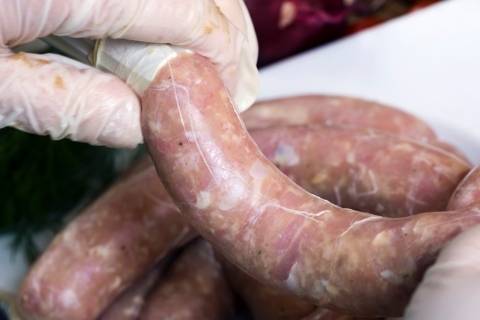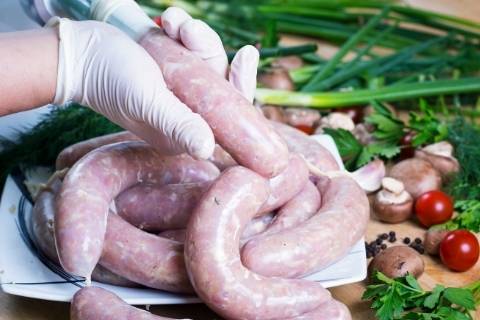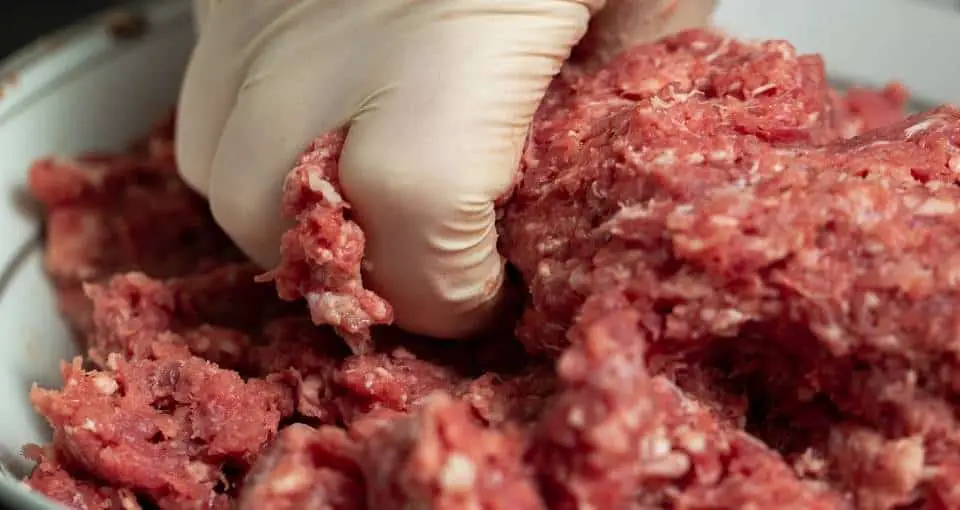It’s getting into that time of year when the weather begins to cool down and we enter mid-autumn. Depending on where you live you may be trying to decide if you should turn the heat on or leave it off and wear a sweatshirt. It is also at this time of year, as the days grow shorter, we begin to crave heartier foods.
One of those foods that peak interest are sausages. Sausages come in many flavors and styles depending on the season. There are sausages for every season but they are an integral part of cuisine throughout the world.
So maybe you are thinking about making your own. What are the components of a sausage and what holds these delicious beauties together?
You may be interested in the following related posts:
- Using Beef Fat: Sausage Making Tips
- 7 Seed Varieties Used In Sausage Making
- Best Meat Cuts For Sausage (Beef, Pork)
- What Makes Breakfast Sausage Different?
What Sausage Consists of…
First, let us have a look at the common components of sausages. It is important to understand while sausage making is a relatively simple process it can also be scientific.
The basic components of sausage are meat, fat, spices, flavors, fillers, and binders.
There is also the casing in which all the ingredients are encased. There is not always a casing, think of some breakfast sausages or sausage patties.
Casings can be natural from pig intestines or artificial, made from collagen and cellulose.
Read More: Can You Eat Sausage Casing?
With all sausages there are meat to fat ratios which is a critical part of the process since the meat is the protein while the fat adds the flavor and moisture content.
So the last thing you would want when making sausage is to lose all flavor and/or moisture, leaving you with a dry and flavorless sausage. This is where binders come into play.

Does Sausage Need A Binder?
Binders are important to making sausage since the job of the binder is to “bind” the fat to the protein and provides a plump and juicy sausage. Now, there are plenty of sausage makers that will tell you that you do not need the binders if you prepare the sausage properly which is accurate.
While you do not need the binder, it certainly helps and makes it somewhat fool proof. If you are not skilled the sausage could be very dry and crumble. Binders are not just for sausage either, if you think of meatballs or meatloaf, they use breadcrumbs or bread cubes.
What the breading does in meatloaf or meatballs is it captures and soaks in the fat from the ground meat which retains the flavor and moisture and binds to the meat.
You can even find that some chefs use binders in their hamburger recipes. Sausage binders love water and keep the fat from clumping together to allow the protein to wrap itself around the fat particles.
They help with flavor, consistency, juiciness, and appearance. They also allow for easier slicing.
There are 4 types of binders used for making sausages. Each one works very well as a binding agent, but they do have their different qualities.
Lets go into more detail about how each binder will behave.
Best Binders For Sausage Making
The most common binders used for making sausage at home are the following:
- Milk Powder
- Soy Protein
- Carrot Fiber
- Rusk
Milk Powder
Evaporated dry milk is a great natural binder that adds great flavor to the sausage through better consistency. This product contains 50% lactose (sugar) and is used in fermented sausages as a source of food for the bacteria.
It also contains 35% of protein. Added at a 3% rate, evaporated dry milk will efficiently bind water and add flavor. Dry milk really creates a much fuller and richer sausage, especially smoked sausage.
In addition to providing you with a high-quality sausage it is also more readily available at your store.
Soy Protein Isolate
There is soy protein isolate which is stronger at about 90% protein and soy protein concentrate which is more readily available and is about 70% protein.
These should be added at 3% of total meat and even at higher rates it should not impart the flavor. Some chefs use a rate of 2 teaspoon per pound of meat as a general rule of thumb.
Soy protein isolate not only acts a great binding agent between fat and meat. It also helps the meat retain moisture during the smoking or cooking process.
Carrot Fiber
Carrot fiber is a great choice for anyone who wants to avoid dairy or soy products. It works just as well to retain moisture as the other binders and has no added flavor. So it does not alter the taste of your sausages.
One problem with carrot fiber is its availability. Carrot fiber food as a food additive can be harder to find than milk powder.
The best places to find this is sausage making specialty stores online or Amazon here.
Rusk
Rusk is more commonly used in the U.K. as a binder for sausages. The reason being that its more readily available. Rusk also is used as filler or additive and varies in texutre.
Think of rusk as very similar to bread crumbs but rusk is traditionally baked instead of simply dried.
One neat thing about rusk as opposed to the other binders is that you can make it at home. The other binders require more extensive processing which makes it difficult to do at home.

Substitute for Milk Powder in Sausage
If you need an allergen free product to use for binding sausage. Your best options are the carrot fiber or rusk. Both are going to be dairy-free and will work as a great substitute.
Types of Sausages and Conclusion
There are three basic categories of sausages. They are fresh or raw sausage, an example would be Italian sausage.
Processed sausage are sausages that are cooked, cured, fermented, or smoked, these would be sausages like pepperoni or bologna. Then there are the dry to semi-dry sausages, think of summer sausage.
Read more: What’s The Difference Between Chorizo, Pepperoni and Salami?
This is important to know since each has its own preparation process and the binder should be adjusted accordingly.
Following a recipe is always recommended for first-time sausage makers as there can be safety standards to follow since it has a high risk of bacteria. Keeping everything cold throughout the process is important.
Binders, while are not essential, are important and helpful in keeping your sausage moist, plump, consistent in texture, and flavorful. The last thing you would want is a sausage that is dry and flavorless.
Evaporated dry milk is a great way to go since it is available and does a great job but soy protein is also great if you have it on hand. There is a slight edge to the dry milk since it gives it a much richer flavor.

